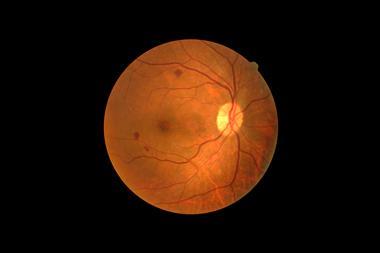A system of video goggles and an artificial retina powered by infrared lasers could restore sight to the blind
Scientists are reporting a futuristic design for retinal prostheses, which, in principle, would dramatically simplify the surgical procedure required to return sight to the blind. The system uses near infrared (NIR) lasers to excite an implanted photodiode array. The radiation alone provides the power for the device, potentially ending the need to implant bulky power coils into the eye.
The most common types of blindness are caused by degradation of photoreceptors in the eye. As the optical neurons remains intact, artificial stimulation offers the tantalising hope of restoring vision.
Daniel Palanker’s group from Stanford University in California, US, now report a new design for a system which can do just that. The first component is an implantable photodiode array (PDA), just a few millimetres across, which interfaces directly with these neurons. The rest of the system is worn like glasses. A video camera mounted on their rim captures images of the environment; a pocket computer interprets these and controls a sophisticated near-to-eye laser projector, which beams signals to the implanted PDA.
Previous retinal prostheses have mostly used visible light, but because this is not energetic enough to stimulate the nerves, power coils have to be implanted into the eye, making the surgical procedure highly invasive.
However, researchers had feared that using the more energetic NIR would damage the retina. ‘The near-to-eye infrared goggles do produce light which is about 1000 times brighter than what you see on a sunny day at the equator,’ says Jim Loudin, a lead author of the work. However, the researchers report that the heating experienced by the tissue can be confined to ‘two orders of magnitude below the ocular safety limit’ using their pulsed laser approach.
The group have carried out extensive electrophysiological testing, proving that the radiation is energetic enough to stimulate the nerves and accurately quantified the heating effect. Loudin says the work so far constituted a proof of concept, but that in vivo trials in rats are underway.
Konstantin Nikolic, a biomedical engineer who works on retinal prostheses at Imperial College London, UK, says the work is really important. ‘The key point here is the use of the quite powerful laser to stimulate the artificial retina. They’ve shown that this works and is safe - it doesn’t overheat the eye.’ But he adds that the technology will not completely restore vision. ‘No one is anywhere near stimulating individual nerve cells, which is what you’d need to restore proper vision.’
Instead, the technology will produce visual perceptions called phosgenes; the coloured flashes seen when closed eyes are rubbed. Loudin says these can be used to form letters, or silhouettes of a person’s surroundings.
‘Will the user be able to see like you and me?’ he says. ‘No. But they will be able to see the end of the sidewalk as a silhouette and maybe write their name.’
Josh Howgego
References
- K Mathieson et al, Nat. Photonics, 2012, DOI: 10.1038/nphoton.2012.104







No comments yet